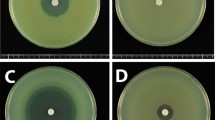Abstract
Minimal inhibitory concentrations of the monobactam carumonam (RO 17-2301) and twelve other antimicrobials were determined using agar dilution against 140 recent nonreplicate clinical isolates of Pseudomonas aeruginosa.The most active drugs were ciprofloxacin, amikacin, imipenem and ceftazidime, inhibiting 96, 91, 90 und 86 percent of the strains, respectively, at or below the susceptibility threshold. The monobactams carumonam and aztreonam were active against 78 and 65 percent of the strains, respectively. Tobramycin inhibited 68 percent of the strains, and gentamicin and netilmicin 50 and 21 percent, respectively. Analysis of correlation coefficients revealed a low correlation between imipenem and the other beta-lactams and a remarkably good correlation between the beta-lactams (excepting imipenem) and the aminoglycosides.
Similar content being viewed by others
References
Sherertz, R. J., Sarubbi, F. A.: A three-year study of nosocomial infections associated withPseudomonas aeruginosa. Journal of Clinical Microbiology 1983, 18: 160–164.
Van der Auwera, P., Schuyteneer, F.: In-vitro susceptibility ofPseudomonas aeruginosa to old and new beta-lactam antibiotics and aminoglycosides. Journal of Antimicrobial Chemotherapy 1983, 11: 511–515.
Sticht-Groh, V.: Tracing ofPseudomonas aeruginosa infection by the use of commercial antisera and pyocin production and the evaluation of the results on the basis of the chi-square test. Zentralblatt für Bakteriologie, Mikrobiologie und Hygiene (A) 1979, 244: 240–250.
Bergan, T.: Epidemiological typing ofPseudomonas aeruginosa. In: Brown, M. R. W. (ed.): Resistance ofPseudomonas aeruginosa. John Wiley and Sons, London 1975, p. 189–235.
Govan, J. R. W., Gillies, R. R.: Further studies in the pyocine typing ofPseudomonas pyocyanea. Journal of Medical Microbiology 1969, 2: 17–25.
Govan, J. R. W.: Pyocin typing ofPseudomonas aeruginosa. In: Bergan, T., Norris, J. R. (ed.): Methods in microbiology. Volume 10. Academic Press, London, 1978, p. 61–91.
National Committee for Clinical Laboratory Standards: Methods for dilution antimicrobial susceptibility tests for bacteria that grow aerobically. Villanova, PA, NCCLS, 1985.
Barry, A. L., Jones, R. N., Thornsberry, C.: Cefsulodin: antibacterial activity and tentative interpretive zone standards for the disk susceptibility test. Antimicrobial Agents and Chemotherapy 1981, 20: 525–529.
Brokopp, C. D., Gomez-Lus, R., Farmer III, J. J.: Serological typing ofPseudomonas aeruginosa: use of commercial antisera and live antigens. Journal of Clinical Microbiology 1977, 5: 640–649.
Legakis, N. J., Aliferopoulou, M., Papavassiliou, J., Papapetropoulou, M.: Serotypes ofPseudomonas aeruginosa in clinical specimens in relation to antibiotic susceptibility. Journal of Clinical Microbiology 1982, 16: 458–463.
Chau, P. Y., Ling, J., Ng, W. S.: Cefoperazone against carbenicillin-resistant isolates ofPseudomonas aeruginosa: comparison with other newer cephalosporins and N-formimidoylthienamycin. Journal of Antimicrobial Chemotherapy 1983, 12: 337–345.
Williams, R. J., Lindridge, M. A., Said, A. A., Livermore, D. M., Williams, J. D.: National survey of antibiotic resistance inPseudomonas aeruginosa. Journal of Antimicrobial Chemotherapy 1984, 14: 9–16.
Righter, J.: In vitro activity of ciprofloxacin, azthreonam and ceftazidime againstSerratia marcescens andPseudomonas aeruginosa. European Journal of Clinical Microbiology 1984, 3: 368–369.
Wiedemann, B., Machka, K., Malottke, R.: Multicenter study of the sensivity ofPseudomonas aeruginosa to antimicrobial agents. European Journal of Clinical Microbiology 1985, 4: 229–230.
Ng, W. W. S., Chau, P. Y., Leung, Y. K., Livermore, D. M.: In vitro activities of RO 17-2301 and azthreonam compared with those of other new beta-lactam antibiotics against clinical isolates ofPseudomonas aeruginosa. Antimicrobial Agents and Chemotherapy 1985, 27: 872–873.
Fernandes, C. J., Stevens, D. A., Ackermann, V. P.: Comparative antibacterial activities of new beta-lactam antibiotics againstPseudomonas aeruginosa. Chemotherapy 1985, 31: 292–296.
National Committee for Clinical Laboratory Standards: Performance standards for antimicrobial disk susceptibility tests. Villanova, PA, NCCLS, 1984.
Livermore, D. M., Williams, R. J., Williams, J. D.: Invitro activity of MK0787 (N-formimidoyl thienamycin) againstPseudomonas aeruginosa and other gramnegative organisms and its stability to their betalactamases. Journal of Antimicrobial Chemotherapy 1981, 8: 355–362.
Tausk, F., Evans, M. E., Patterson, L. S., Federspiel, C., Stratton, C. W.: Imipenem-induced resistance to antipseudomonal beta-lactams inPseudomonas aeruginosa. Antimicrobial Agents and Chemotherapy 1985, 28: 41–45.
Yoshimura, F., Nikaido, H.: Diffusion of bcta-lactam antibiotics through the porin channels ofEscherichia coli K 12. Antimicrobial Agents and Chemotherapy 1985, 27: 84–92.
Livermore, D. M., Williams, R. J., Williams, J. D.: Comparison of the beta-lactamase stability and the in-vitro activity of cefoperazone, cefotaxime, cefsulodin, ceftazidime, moxalactam and ceftriaxone againstPseudomonas aeruginosa. Journal of Antimicrobial Chemotherapy 1981, 8: 323–331.
Livermore, D. M.: Beta-lactamases ofPseudomonas aeruginosa. Journal of Antimicrobial Chemotherapy 1982, 10: 168–171.
Forster, T. J.: Plasmid-determined resistance to antimicrobial drugs and toxic metal ions in bacteria. Microbiological Reviews 1983, 47: 361–409.
Rivera, M. J., Vitoria, M. A., Navarro, M., Robledano, L., Chocarro, P., Gomez Lus, R.: Hospital dissemination among gram-negative bacillus strains of an inc M plasmid encoding an AAC (3) and a TEM-1 betalactamase. Drugs under Experimental and Clinical Research 1984, 10: 789–795.
Jacoby, G. A., Matthew, M.: The distribution of beta-lactamase genes on plasmids found inPseudomonas. Plasmid 1979, 2: 41–47.
Goldstein, F. W., Gutmann, L., Williamson, R., Collatz, E., Acar, J. F.: In vivo and in vitro emergence of simultaneous resistance to both beta-lactam and aminoglycoside antibiotics in a strain ofSerratia marcescens. Annales de Microbiologic (A) 1983, 134: 329–337.
Michael, P. R., Alford, R. H., McGee, Z. A.: Superior activity of N-formimidoyl thienamycin against gentamicin-resistantPseudomonas aeruginosa. Antimicrobial Agents and Chemotherapy 1981. 20: 702–704.
Author information
Authors and Affiliations
Rights and permissions
About this article
Cite this article
Vurma-Rapp, U., Kayser, F.H. In vitro activity of carumonam (RO 17-2301) and twelve other antimicrobials against clinical isolates ofPseudomonas aeruginosa . Eur. J, Clin. Microbiol. 5, 292–296 (1986). https://doi.org/10.1007/BF02017784
Issue Date:
DOI: https://doi.org/10.1007/BF02017784




